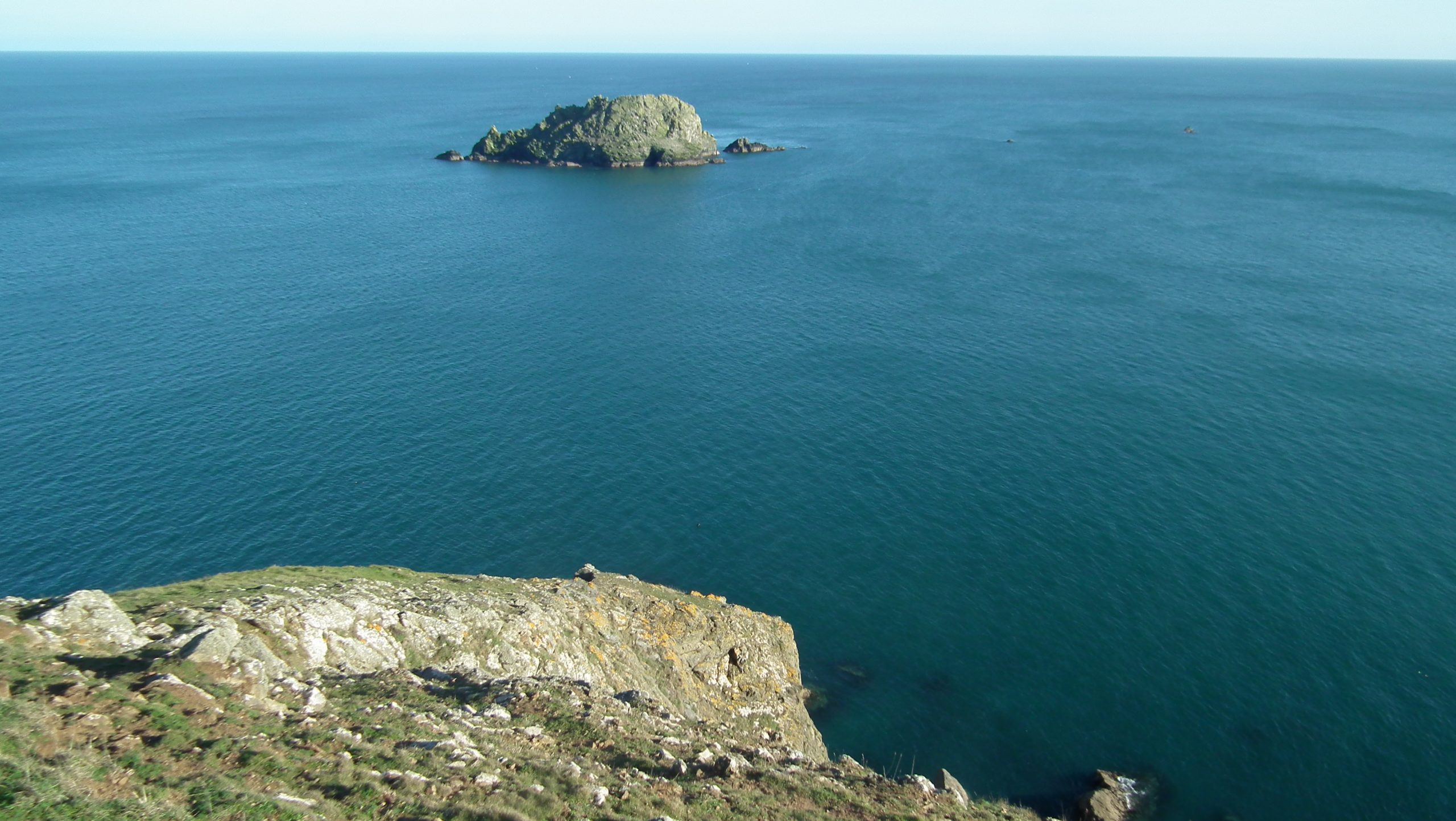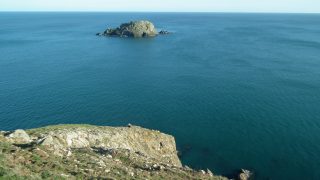 Gull Rock is a special place on the Roseland. It provides refuge, roosting and breeding places for many sea birds, and is particularly interesting in June or July, for its breeding auk colony of Guillemots and Razorbills, which have returned from wandering the seas to breed on its ledges adding to its itinerant population of Great Black-backed Gull, Herring Gull, Cormorant and Shag.
Gull Rock is a special place on the Roseland. It provides refuge, roosting and breeding places for many sea birds, and is particularly interesting in June or July, for its breeding auk colony of Guillemots and Razorbills, which have returned from wandering the seas to breed on its ledges adding to its itinerant population of Great Black-backed Gull, Herring Gull, Cormorant and Shag.
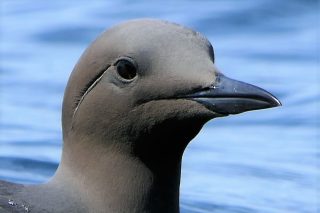
Just imagine the Guillemo which spends 8 months of her life further out at sea diving down from the surface for all her food. She then comes to Gull Rock and lays a single egg (rarely 2), on a narrow rocky ledge immediately above a sheer drop to the sea, in what is the smallest breeding territory of all birds. Other Guillemots follow cramming onto the ledge, side by side, mostly standing upright like penguins, each protecting their own egg by resting it on their webbed feet and incubating it with their lower body. Her male lifelong partner shares the incubation. And they often live for 10 years or more.
The egg has a rough texture, can be any colour of the rainbow and has an elongated design which means it rolls around itself if left, rather than fall off the ledge into the sea! The chicks hatch after about 4 weeks and are then vulnerable to threat from Great Black-backed Gulls and corvids marauding for easy pickings. Many are predated but those chicks, once partially fledged, which takes around 3 weeks, then jump for the water far below, as they cannot even fly for about another 3 weeks. Their parents stay with them then for around 2 months and then they are on their own.
A good time to watch the island now is on a sunny afternoon with a breeze blowing onshore; and a good place to watch it from is the seat at the Veryan bunker cliff edge towards the Kiberick end of the Nare Head. But please take care as the cliff edge is unfenced and extremely steep. It is nearly 300 feet high here.
The sunlight will be on the rock face opposite you at that time; and, with the onshore wind you will be able to hear the strange cacophony of communicating noises from the bird colony. And if you are lucky you might be able to smell the guano on the island.
There are very few bird species which stay on Gull Rock, but the numbers of those that do mean that, even with birds in general decline, there appears to be guano aplenty.
I was reminded recently of the temptations of guano or bird poo, when one of our social media contributors recalled landing on Gull Rock, as a youngster, to load up bags of guano for his dad’s greenhouse. “Tomatoes like oranges and sweet” was his comment and he survived to tell the tale. But, don’t even think about it. The rocks are far too dangerous and the sea below treacherous and full of unexpected currents.
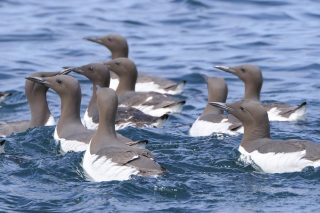 To view the activity on the island a pair of binoculars is essential as the island is about 600 metres offshore from the Nare Head, near Kiberick Cove. Its seaward side has a slope of about 70 degrees but its landward side is more or less vertical, making it safe for birds but most definitely not for people, especially as there is an unpredictable and significant rise and fall in swell, no landing point for boats and no paths.
To view the activity on the island a pair of binoculars is essential as the island is about 600 metres offshore from the Nare Head, near Kiberick Cove. Its seaward side has a slope of about 70 degrees but its landward side is more or less vertical, making it safe for birds but most definitely not for people, especially as there is an unpredictable and significant rise and fall in swell, no landing point for boats and no paths.
You will probably see in addition to those birds mentioned earlier, gannets fishing and fulmars gliding, ravens croaking and, if you are really lucky, a peregrine, a kestrel or even, rarely, a chough passing, but to my knowledge none of these now nests on Gull Rock.
Just over 50 years ago a large colony of 288 nesting pairs of Kittiwake thrived there, but today there are none. Similarly, the Puffin used to nest there in large numbers 100 years ago but dwindled down to only a few birds by the 1950s and then finally vanished around 1958.
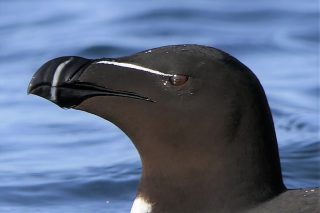 Yet the guillemot is thriving now, with over 200 birds, on the Gull Rock from May until early August, making it the largest colony on Cornwall’s south coast, although not all of the Guillemots are breeders. The Razorbill was noted in large numbers about 120 years ago, then fell to its low point in 1967 to just 19 birds It is making a presence now although it is outnumbered, about 4 to 1 by the Guillemot, so it is estimated there may be around 40 Razorbill today.
Yet the guillemot is thriving now, with over 200 birds, on the Gull Rock from May until early August, making it the largest colony on Cornwall’s south coast, although not all of the Guillemots are breeders. The Razorbill was noted in large numbers about 120 years ago, then fell to its low point in 1967 to just 19 birds It is making a presence now although it is outnumbered, about 4 to 1 by the Guillemot, so it is estimated there may be around 40 Razorbill today.
To find these auks look closely above the large central cave mouth at the ledge running parallel to it like a large mantelpiece. The guillemots tend to congregate there in bright white upright rows, frequently peeling off, wings whirring, down to fish in the nearby water below them. Look to the left hand (north end) of the Gull Rock and there are smaller groups, some higher up than others. This tends to be where the Razorbills gather. Their resting place for their single egg is a little more subtle. They use crevices, or boulders or even small holes to disguise their position.
I hope you find this interesting and useful.
To help complete the picture please send in any records you have of numbers and species to bird-news@cbwps.org.uk and they may be published on their recent sightings page. Alternatively send them to ERRCIS by email, orks.org.uk or, via the App with the name, ORKS.
References and acknowledgements.
Birds of the Cornish Coast. R.D. Penallurick. Bradford Barton. (out of print)
RSPB Seabirds. Marianne Taylor. Bloomsbury.
A field guide to the nests, eggs, and nestlings of British and European Birds. Colin Harrison. Collins (out of print)
Various “Birds in Cornwall” annual reports of the CBWPS. ( Cornwall Birdwatching and Preservation Society.)
Bird photography by Rupert Kirkwood, (aka The Lone Kayaker) to whom many grateful thanks for allowing use of his copyrighted photos.
Advice from Simon Taylor, BTO regional representative in Cornwall.
Upcoming Wild Roseland Walks and Talks – dates for your diary
Note that all events are free but a small donation of £3 would be welcomed.
Our evening talks are scheduled to start in September, (Covid 19 protocols allowing.)
To date some very interesting speakers have been booked.
Each event will be held on the last Tuesday evening of the month in Gerrans Parish Memorial Hall.
The confirmed programme so far is as follows.
Tuesday, 29th September:- Recording Wildlife. Staff from ERCCIS will lead a practical workshop. Please bring your mobile phones!
Tuesday, 24th November:- The Flora of Cornwall, with particular reference to the Roseland. Colin French, who has just completed and published the up to date survey and produced the atlas of Cornwall’s Flora, will host the evening.
Tuesday, 26th January,2021:- The Return of the Lone Kayaker, Rupert Kirkwood, with his latest local photographs of wildlife from the sea and rivers around our coastline. (Standing room only last time)
Tuesday, 30th March, 2021:- Dragonflies and Damselflies. An evening with Dave Cooper, the Dragonfly county recorder for East Cornwall.
There are others still to be confirmed but I thought you would appreciate these so that they can be fixed in your diaries early.
Or marked on your calendar for 2020 and our new Wild Roseland calendar for 2021.
This calendar, featuring photographs of the Roseland from Jane Lewarne, has been gifted by Jane to raise funds for Wild Roseland’s activities. We truly appreciate her generosity, and knowing how much admired her evocative photographs are, both locally and on TV’s weather watcher, will let you know as soon as they are in local outlets.
Thanks for supporting Wild Roseland.
David Hall.
Contributors:
Article by David Hall. Edited by Tara Robinson.
Wild Roseland is a group of volunteers who care passionately about looking after the nature and landscape of the Roseland peninsula in south Cornwall. Through a number of initiatives and projects, the aim is to inspire and enhance the conservation of this special place for all.
[[Usual social media links]]Image credits:
Bird photography: Rupert Kirkwood

